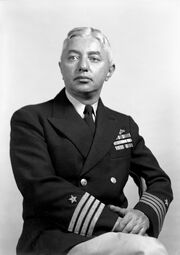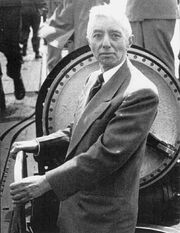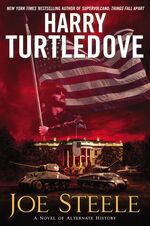| ||||||||||||||||||||||||||||||||||||||
Hyman George Rickover (January 27, 1900 – July 8, 1986) was a United States Navy admiral who directed the original development of naval nuclear propulsion and controlled its operations for three decades as director of Naval Reactors. This earned him the nickname "Father of the Nuclear Navy". In addition, he oversaw the development of the Shippingport Atomic Power Station, the world's first commercial pressurized water reactor used for generating electricity.
With 63 years of active duty, Rickover is the longest serving naval officer in U.S. history as of this writing. He was made a four-star admiral in 1973. However, throughout much of his career, Rickover maintained an iron grip on the nuclear reactor operations, which was seen as increasingly detrimental to the program and the Navy overall. After surviving multiple attempts by the U.S. Navy to force his retirement, Rickover finally surrendered to retirement in 1982. He died in 1986 after a series of strokes.
Hyman Rickover in Joe Steele
In early 1946, President Joe Steele learned of German attempts to develop a new type of bomb using uranium. He had Captain Hyman Rickover research the matter to determine if such a bomb was possible. With the information Rickover provided, Steele confronted Albert Einstein who admitted he had kept this information from Steele. After ordering Einstein's arrest, Steele had Rickover (who'd been present for the confrontation) begin a project to develop an atomic bomb.[1]
In mid-1949, Captain Rickover's work came to fruition. On August 6, 1949, a B-29 dropped an atomic bomb on the North Japan city of Sendai.[2] Three days later, the Soviets dropped a retaliatory bomb on the South Japan city of Nagano.[3] The fear of tit for tat bombings of cities led to end of the Japanese War shortly thereafter with status quo ante bellum as a result.[4]
Nevertheless, Rickover was promoted to admiral for the successful development of the bomb. He had used a number of physicists who had been encamped as wreckers so Teller, Feynman and Cohen were freed as a result.[5]
Literary comment
In the short story, Edward Teller is named as the head of the U.S. atomic bomb project, which drops its product on Sapporo, not Sendai. Rickover is not named.
Hyman Rickover in Southern Victory

Captain Rickover at the Joint Committee Meeting
Hyman Rickover was a captain in the U.S. Navy. A blunt man, Rickover was called before the Joint Committee on the Conduct of the War in 1944, at the end of the Second Great War when the Confederate States was going down to defeat. The Committee, with little to do, attempted to grill Rickover about why the U.S. was having trouble matching German[6] submersible designs. Rickover assured the Committee that the U.S would be building them faster than Germany did, but that the designs had only recently entered U.S. hands, and pointedly chastened a Dakota Senator for demanding the impossible.[7]
See Also
- Leslie Groves, historical American general and director of the Manhattan Project in OTL and in the Worldwar series. Rickover plays an analogous role in the novel Joe Steele.
References
- ↑ Joe Steele, pgs. 315-320, HC.
- ↑ Ibid, pgs. 368-369.
- ↑ Ibid, pg. 371.
- ↑ Ibid, pgs. 372-373.
- ↑ Ibid, pg. 393.
- ↑ See Inconsistencies in Turtledove's Work#Inconsistencies in Southern Victory
- ↑ In at the Death, pg. 356.
| |||||||||||||||||||












